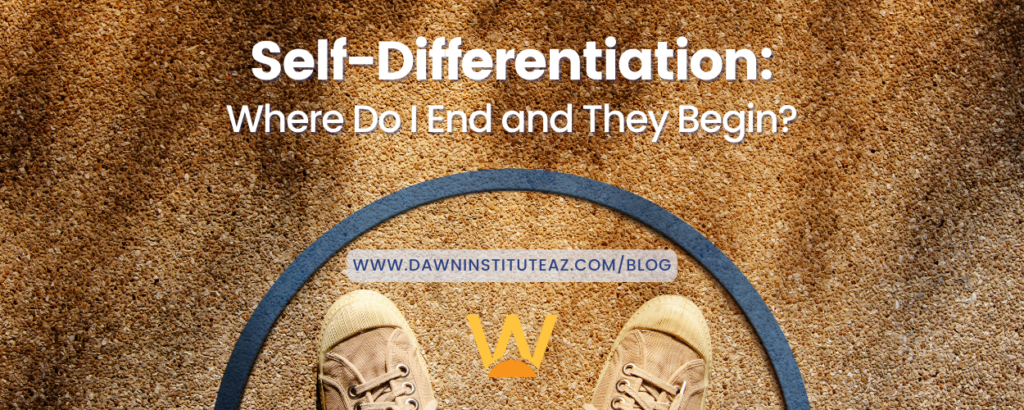Where do I end and they begin? A major milestone in every independent adult’s life is establishing self-differentiation. What is differentiation of self, you ask? Well, it’s the beginning of adulthood.
Self-differentiation describes a few processes but begins with a separation from a person’s family of origin (we, in the industry call this the FOO) as they embark on their own journey in life. In short, it’s growing up, but it’s not just growing up — it’s figuring out who you are and developing your own secure identity.
This milestone is typically smooth for folks who grew up in healthy homes and were raised to be confident by well-round parental figures. Well… smooth-ish, because it’s often a difficult transition — but most folks come out the other side unscathed. However, for anyone who struggled with trauma early on, was raised by parents who hadn’t worked through their own traumas, or grew up in a dysfunctional FOO, differentiation isn’t so “smoothish” at all.
What is Differentiation of Self?
Often analyzed on a continuum, differentiation of self is how much you are able to be yourself, with your own identity, emotions, and opinions, even when you are around people with whom you have very close relationships. Your level of differentiation, or how differentiated you are, is contingent upon how you separate from your FOO when the time comes. Then, this dynamic carries over to other relationships throughout your life.
There are two ways we look at self-differentiation: internally and externally.
- Internally
How a person separates and makes distinctions between their emotions and their thoughts. In other words, recognizing that just because you are feeling some type of way doesn’t mean
you have to act on it or forego using rational thought first. It’s being able to tell the difference between thoughts and feelings and knowing when your emotions are balanced or need regulating. - Externally
How a person separates and distinguishes their emotions and thoughts from the important emotions and thoughts of others. In other words, it’s how much you can maintain your own values and opinions, even when significant people in your life have different values and opinions. So basically, how much are you able to be you and let them be them?
The Process of Self-Differentiating
So, it’s not as simple as turning 18 years old and moving out of your parents’ house. Self-differentiating begins internally. It’s being able to regulate your emotions and make wise decisions that are based on your values and knowledge. It’s being able to have healthy boundaries and maintain your sense of self even when people you care about don’t agree.
I tell my clients who come from dysfunctional FOO’s all the time that a person can move thousands of miles away from their FOO, have no contact with them, and still be undifferentiated. If you find yourself making choices to spite your FOO or continuing unhealthy relationship dynamics with them into adulthood, that’s undifferentiation. If you find yourself doing things others want and sacrificing your own needs, that’s undifferentiation. If you find yourself often having to apologize for the way you acted because you acted out of emotions, that’s undifferentiation.
A self-differentiated person, even one who comes from a dysfunctional FOO, is someone who has good self-awareness, maintains their confidence, lives by their values, and does not get their feathers ruffled by people who don’t agree with them or are emotionally unhealthy.
What To Do If You Have a Low Level of Self-Differentiation
Well, that’s where therapy comes in! We are accepting clients at Dawn Institute, by the way. If therapy isn’t working to help you with your self-differentiation, chances are they are not helping you with the right things. Of course, you don’t have to do therapy, it’s just the most effective and quickest way.
You can also try self-help books. There are some great ones, actually. The trick is to read the reviews; if professionals in the field, counselors, psychologists, psychiatrists, etc. are writing positive reviews, it’s probably a helpful book.
How to Self-Differentiate
So here is a list of things to work on, whether you’re working with a therapist, following a self-help book, journaling on your own, processing with trusted and healthy loved ones, or completing a therapy workbook:
- Learn self-regulation skills to help you manage your moods.
- Figure out what your negative core beliefs about yourself and the world are, then debunk them and stop allowing yourself to use them.
- Process your attachment traumas. This may be difficult and traumatic for some, so I highly recommend working with a therapist on this one.
- If you recognize growing up in a dysfunctional FOO, mourn the loss of the healthy family relationships you didn’t get. “Mourning the loss” may sound harsh, but it’s important to be able to acknowledge that your experiences were not normal. Recognizing this will greatly help with the next step.
- Create healthy boundaries. You don’t have to start with your FOO, but the FOO must be included at some point. Remember, boundaries may be external — like physical boundaries — or internal — like regulating how much you allow someone to get to you.
- Finally, give yourself grace and allow healthy people to help you. Be courageous and vulnerable with healthy folks. If you don’t know how to spot a safe, healthy person then please schedule an appointment with a therapist because we will teach you how to recognize them.
You don’t have to get help here at Dawn Institute but do reach out to some sort of support system, because having a low level of self-differentiation is like not having control of your life. Take back your control.

